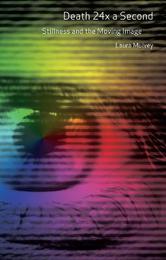
|
Death 24X A Second
Paperback / softback
Main Details
| Title |
Death 24X A Second
|
| Authors and Contributors |
By (author) Laura Mulvey
|
| Physical Properties |
| Format:Paperback / softback | | Pages:240 |
|
| Category/Genre | Film theory and criticism |
|---|
| ISBN/Barcode |
9781861892638
|
| Classifications | Dewey:791.43 |
|---|
| Audience | | General | | Undergraduate | | Postgraduate, Research & Scholarly | | Professional & Vocational | |
|---|
|
Publishing Details |
| Publisher |
Reaktion Books
|
| Imprint |
Reaktion Books
|
| Publication Date |
1 November 2005 |
| Publication Country |
United Kingdom
|
Description
In Death 24 x a Second, Laura Mulvey addresses some of the key questions of film theory, semiotics, spectatorship and narrative. New media technologies, such as dvd, have transformed modes of film consumption and thus affected viewers? relationship to the image and to narrative structure. dvd gives viewers control of both image and story, so that films produced to be seen collectively and followed as their linear narratives demand may be found to contain unexpected (even unintended) and multiple structures of pleasure. The tension between the still frame and the moving image coincides with the cinema?s capacity to capture the appearance of life and preserve it after death. Mulvey proposes that with the arrival of new technologies and new ways of experiencing the cinematic image, film?s hidden stillness comes to the fore, thereby acquiring a new accessibility and visibility. The individual frame, the projected film?s best-kept secret, can now be revealed, by anyone, at the simple touch of a button. Easy access to repetition, slow motion and the freeze-frame may well shift the spectator?s pleasure to a fetishistic rather than a voyeuristic investment in the cinematic object. Yet, there is another, narrative aspect to the stillness/movement tension that is not specific to the cinema but has been reworked and reinvented within the constraints of mass entertainment story-telling. Mulvey detects, at the present moment, an attraction to endings, and with the threat of ?ending? hanging over the cinema itself, there is an extra awareness of the deathlike properties of narrative closure. Inevitably, such a conjunction shifts the attention of the psychoanalytically influenced critic away from a preoccupation with the erotic, as the propelling force of narrative, towards death. Freud?s concept of the death drive as applied to narrative structure allows a theoretical reassessment of cinematic story-telling which ultimately converges with cinema?s inherent stillness, its own death-like properties.
Author Biography
Laura Mulvey is Professor of Film and Media Studies at Birkbeck College, University of London and the author of Visual and Other Pleasures (1989), Citizen Kane (1992) and Fetishism and Curiosity (1996)
Reviewselegiac ... a wonderful close analysis. Despite the melancholy in cinema's enounters with a fleeting past, the prospects opened up by filmic slowness are, for Mulvey, productive of optimism. Times Higher Education Supplement Rethinking the fundamentals of fim history through modern audiovisual technology Independent on Sunday Mulvey ... continues to provoke new ways of seeing - or re-seeing - the cinema we think we know. Film Comment Death 24x a Second takes up both the challenge to critical thinking represented by new technological developments, and the impulse towards reflection on film's past that they have occasioned ... a thoughtful book. New Left Review
|